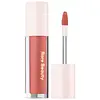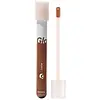What's inside
What's inside
 Key Ingredients
Key Ingredients

 Benefits
Benefits

 Concerns
Concerns

 Ingredients Side-by-side
Ingredients Side-by-side

Isododecane
EmollientSynthetic Fluorphlogopite
Silica
AbrasiveOctyldodecanol
EmollientHydrogenated Styrene/Isoprene Copolymer
Trimethylsiloxysilicate
EmollientDisteardimonium Hectorite
StabilisingMica
Cosmetic Colorant1,2-Hexanediol
Skin ConditioningCaprylyl Glycol
EmollientTocopheryl Acetate
AntioxidantDicalcium Phosphate
AbrasiveTin Oxide
AbrasivePentaerythrityl Tetra-Di-T-Butyl Hydroxyhydrocinnamate
AntioxidantCI 19140
Cosmetic ColorantCI 42090
Cosmetic ColorantCI 77491
Cosmetic ColorantCI 77492
Cosmetic ColorantCI 77742
Cosmetic ColorantCI 77891
Cosmetic ColorantIsododecane, Synthetic Fluorphlogopite, Silica, Octyldodecanol, Hydrogenated Styrene/Isoprene Copolymer, Trimethylsiloxysilicate, Disteardimonium Hectorite, Mica, 1,2-Hexanediol, Caprylyl Glycol, Tocopheryl Acetate, Dicalcium Phosphate, Tin Oxide, Pentaerythrityl Tetra-Di-T-Butyl Hydroxyhydrocinnamate, CI 19140, CI 42090, CI 77491, CI 77492, CI 77742, CI 77891
Isododecane
EmollientMica
Cosmetic ColorantTrimethylsiloxysilicate
EmollientAluminum Starch Octenylsuccinate
AbsorbentDiisostearyl Malate
EmollientHydrogenated Styrene/Isoprene Copolymer
Disteardimonium Hectorite
StabilisingPolyethylene
AbrasiveTrihydroxystearin
Skin ConditioningSynthetic Fluorphlogopite
Polymethylsilsesquioxane
Silica
AbrasivePropylene Carbonate
SolventLauroyl Lysine
Skin ConditioningPentaerythrityl Tetra-Di-T-Butyl Hydroxyhydrocinnamate
AntioxidantAluminum Calcium Sodium Silicate
Tin Oxide
AbrasiveCI 77891
Cosmetic ColorantIron Oxides
CI 77000
Cosmetic ColorantIsododecane, Mica, Trimethylsiloxysilicate, Aluminum Starch Octenylsuccinate, Diisostearyl Malate, Hydrogenated Styrene/Isoprene Copolymer, Disteardimonium Hectorite, Polyethylene, Trihydroxystearin, Synthetic Fluorphlogopite, Polymethylsilsesquioxane, Silica, Propylene Carbonate, Lauroyl Lysine, Pentaerythrityl Tetra-Di-T-Butyl Hydroxyhydrocinnamate, Aluminum Calcium Sodium Silicate, Tin Oxide, CI 77891, Iron Oxides, CI 77000
 Reviews
Reviews

Ingredients Explained
These ingredients are found in both products.
Ingredients higher up in an ingredient list are typically present in a larger amount.
Ci 77891 is a white pigment from Titanium dioxide. It is naturally found in minerals such as rutile and ilmenite.
It's main function is to add a white color to cosmetics. It can also be mixed with other colors to create different shades.
Ci 77891 is commonly found in sunscreens due to its ability to block UV rays.
Learn more about CI 77891Disteardimonium Hectorite comes from the clay mineral named hectorite. It is used to add thickness to a product.
It can also help stabilize a product by helping to disperse other ingredients.
Hectorite is a rare, white clay mineral.
Learn more about Disteardimonium HectoriteWe don't have a description for Hydrogenated Styrene/Isoprene Copolymer yet.
Isododecane is a fragrance, emollient, and solvent.
As an emollient, it helps your skin stay soft and hydrated. Emollients help trap moisture into your skin.
Isododecane's role as a solvent makes it a great texture enhancer. It spreads smoothly on skin and does not leave a sticky feeling behind. Isododecane also helps prevent color transfer in makeup products.
Isododecane is not absorbed into skin.
Learn more about IsododecaneMica is a naturally occurring mineral used to add shimmer and color in cosmetics. It can also help improve the texture of a product or give it an opaque, white/silver color.
Serecite is the name for very fine but ragged grains of mica.
This ingredient is often coated with metal oxides like titanium dioxide. Trace amounts of heavy metals may be found in mica, but these metals are not harmful in our personal products.
Mica has been used since prehistoric times throughout the world. Ancient Egyptian, Indian, Greek, Roman, Aztec, and Chinese civilizations have used mica.
Learn more about MicaPentaerythrityl Tetra-Di-T-Butyl Hydroxyhydrocinnamate (long name, huh?) is a synthetic antioxidant.
It is used to help stabilize other antioxidants or prevent the color from changing in a product.
As an antioxidant, it helps fight free-radical molecules. Free-radical molecules are capable of damaging our cells and other genetic material. Thus, antioxidants may reduce the signs of aging.
This ingredient is oil-soluble.
Learn more about Pentaerythrityl Tetra-Di-T-Butyl HydroxyhydrocinnamateSilica, also known as silicon dioxide, is a naturally occurring mineral. It is used as a fine, spherical, and porous powder in cosmetics.
Though it has exfoliant properties, the function of silica varies depending on the product.
The unique structure of silica enhances the spreadability and adds smoothness, making it a great texture enhancer.
It is also used as an active carrier, emulsifier, and mattifier due to its ability to absorb excess oil.
In some products, tiny microneedles called spicules are made from silica or hydrolyzed sponge. When you rub them in, they lightly polish away dead skin layers and enhance the penetration of active ingredients.
Learn more about SilicaSynthetic Fluorphlogopite is the synthethic version of mica. It consists of fluorine, aluminum and silicate.
Synthetic Fluorphlogopite is used to add volume to products.
It is considered non-irritating on the skin.
Learn more about Synthetic FluorphlogopiteTin Oxide is an inorganic oxide used to add opacity and volume to a product. In nature, it is already found in mineral form. The main ore of tin is an opaque and shiny mineral called casseterite.
Tin Oxide helps remove translucency in a product, or make it more opaque. Besides adding opacity, tin oxide is used for bulking to add volume.
This silicone is an emollient. Emollients create a thin film on the skin to prevent moisture from escaping.
It is not soluble in water and helps increase water-resistance in products.
According to a manufacturer, it can blend seamlessly with silicone oils, such as Cyclopentasiloxane.
Learn more about Trimethylsiloxysilicate